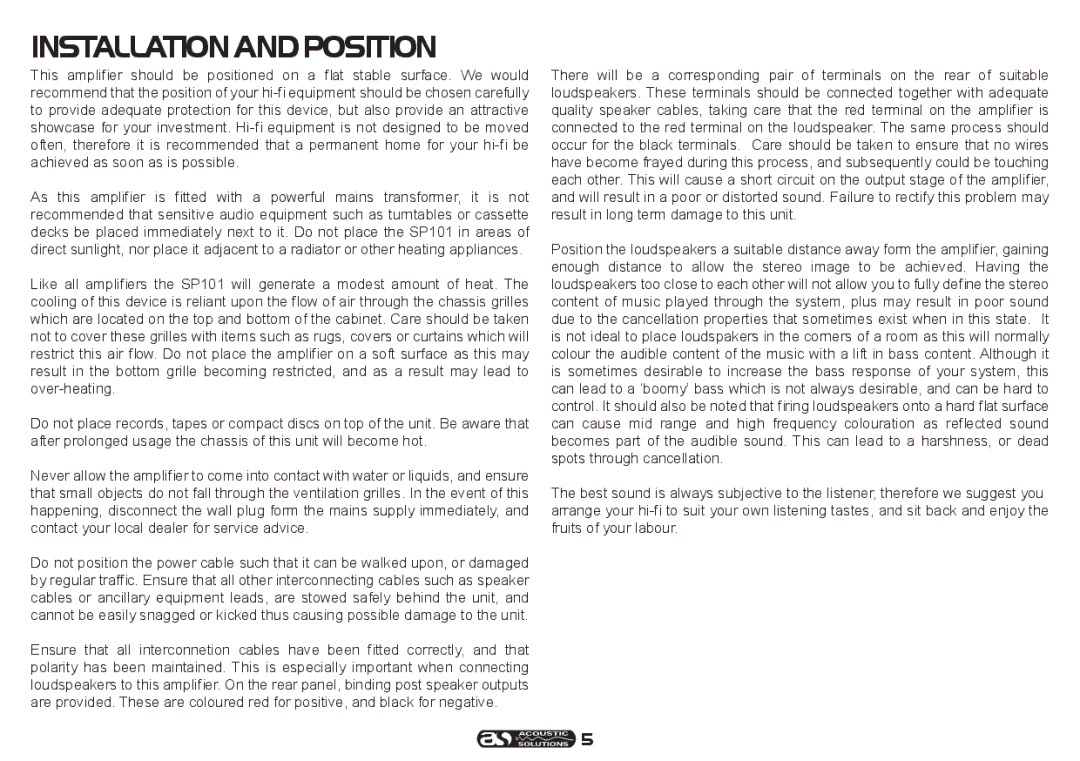INSTALLATIONANDPOSITION
This amplifier should be positioned on a flat stable surface. We would recommend that the position of your
As this amplifier is fitted with a powerful mains transformer, it is not recommended that sensitive audio equipment such as turntables or cassette decks be placed immediately next to it. Do not place the SP101 in areas of direct sunlight, nor place it adjacent to a radiator or other heating appliances.
Like all amplifiers the SP101 will generate a modest amount of heat. The cooling of this device is reliant upon the flow of air through the chassis grilles which are located on the top and bottom of the cabinet. Care should be taken not to cover these grilles with items such as rugs, covers or curtains which will restrict this air flow. Do not place the amplifier on a soft surface as this may result in the bottom grille becoming restricted, and as a result may lead to
Do not place records, tapes or compact discs on top of the unit. Be aware that after prolonged usage the chassis of this unit will become hot.
Never allow the amplifier to come into contact with water or liquids, and ensure that small objects do not fall through the ventilation grilles. In the event of this happening, disconnect the wall plug form the mains supply immediately, and contact your local dealer for service advice.
Do not position the power cable such that it can be walked upon, or damaged by regular traffic. Ensure that all other interconnecting cables such as speaker cables or ancillary equipment leads, are stowed safely behind the unit, and cannot be easily snagged or kicked thus causing possible damage to the unit.
Ensure that all interconnetion cables have been fitted correctly, and that polarity has been maintained. This is especially important when connecting loudspeakers to this amplifier. On the rear panel, binding post speaker outputs are provided. These are coloured red for positive, and black for negative.
There will be a corresponding pair of terminals on the rear of suitable loudspeakers. These terminals should be connected together with adequate quality speaker cables, taking care that the red terminal on the amplifier is connected to the red terminal on the loudspeaker. The same process should occur for the black terminals. Care should be taken to ensure that no wires have become frayed during this process, and subsequently could be touching each other. This will cause a short circuit on the output stage of the amplifier, and will result in a poor or distorted sound. Failure to rectify this problem may result in long term damage to this unit.
Position the loudspeakers a suitable distance away form the amplifier, gaining enough distance to allow the stereo image to be achieved. Having the loudspeakers too close to each other will not allow you to fully define the stereo content of music played through the system, plus may result in poor sound due to the cancellation properties that sometimes exist when in this state. It is not ideal to place loudspakers in the corners of a room as this will normally colour the audible content of the music with a lift in bass content. Although it is sometimes desirable to increase the bass response of your system, this can lead to a ‘boomy’ bass which is not always desirable, and can be hard to control. It should also be noted that firing loudspeakers onto a hard flat surface can cause mid range and high frequency colouration as reflected sound becomes part of the audible sound. This can lead to a harshness, or dead spots through cancellation.
The best sound is always subjective to the listener, therefore we suggest you arrange your
5
